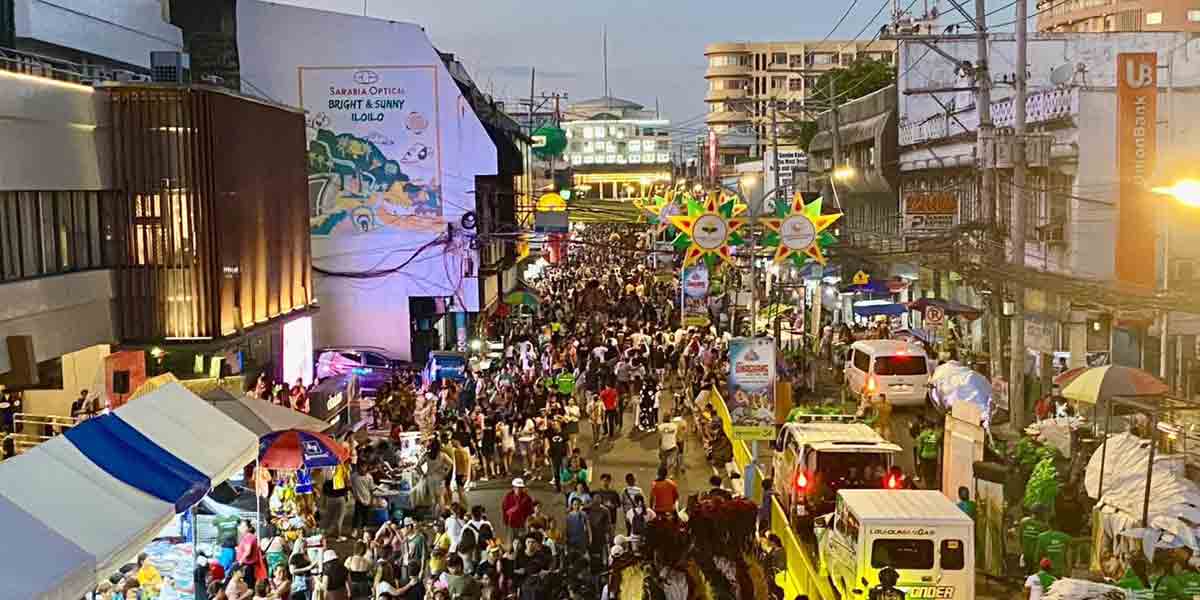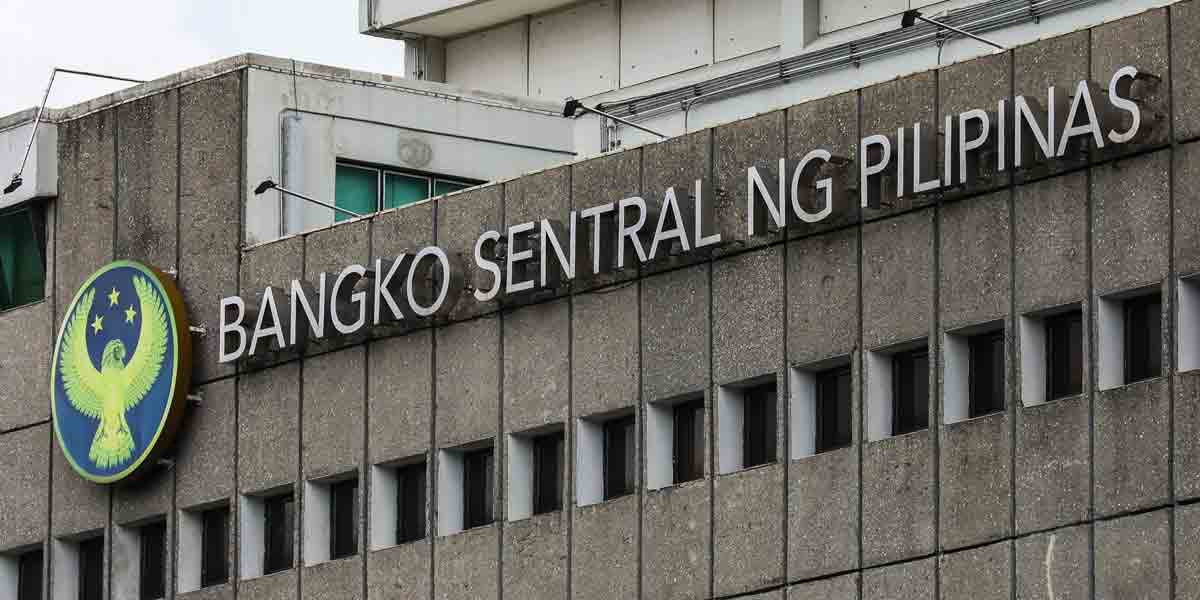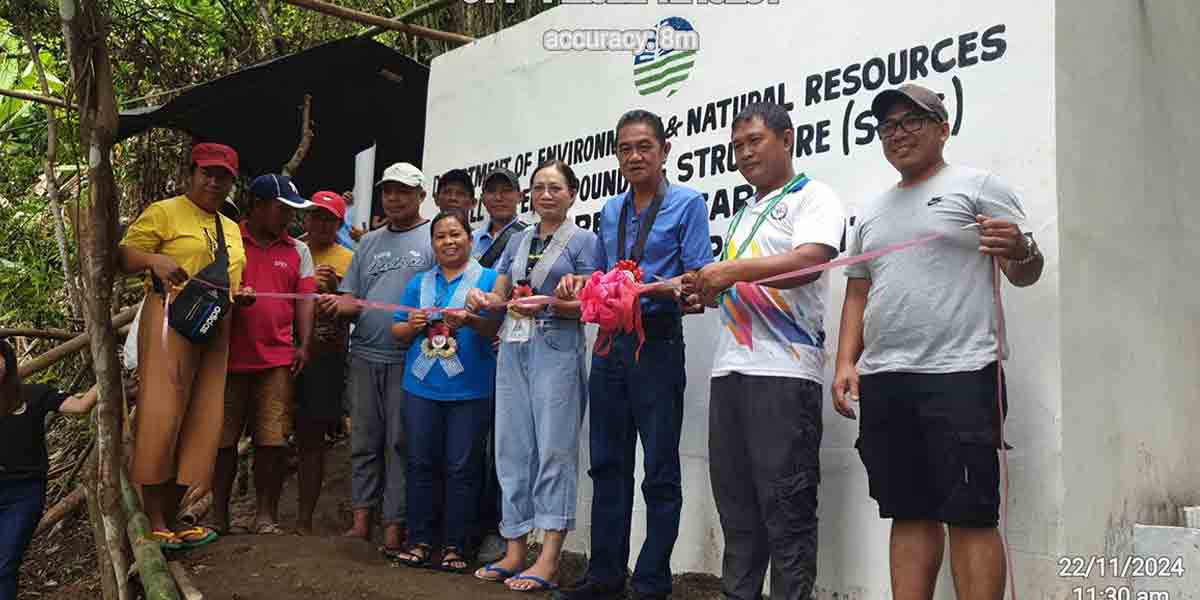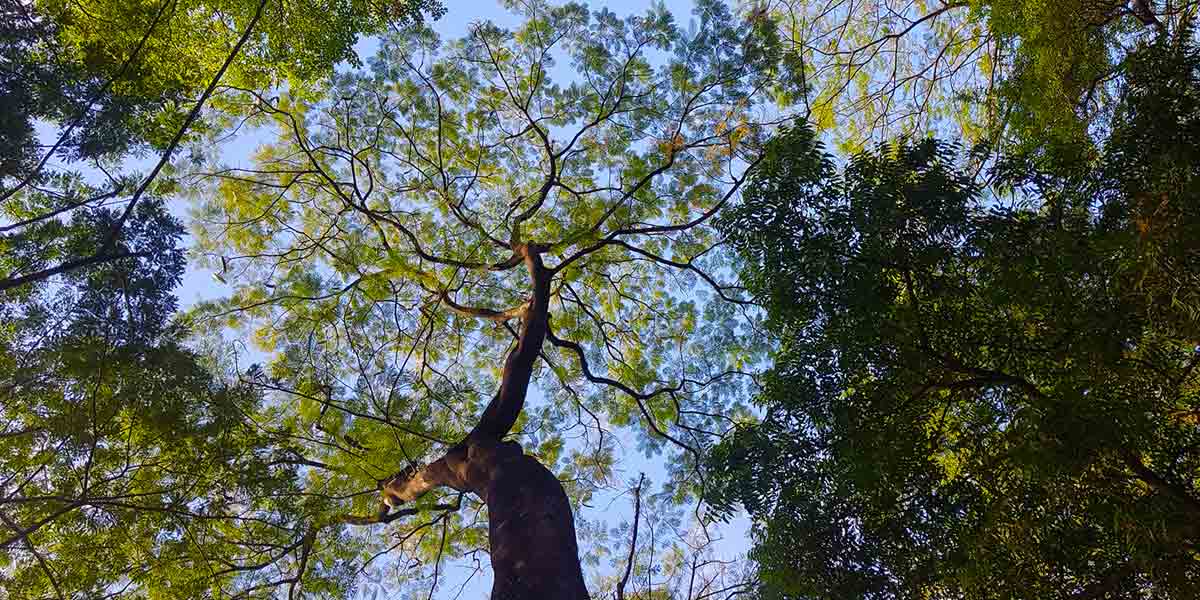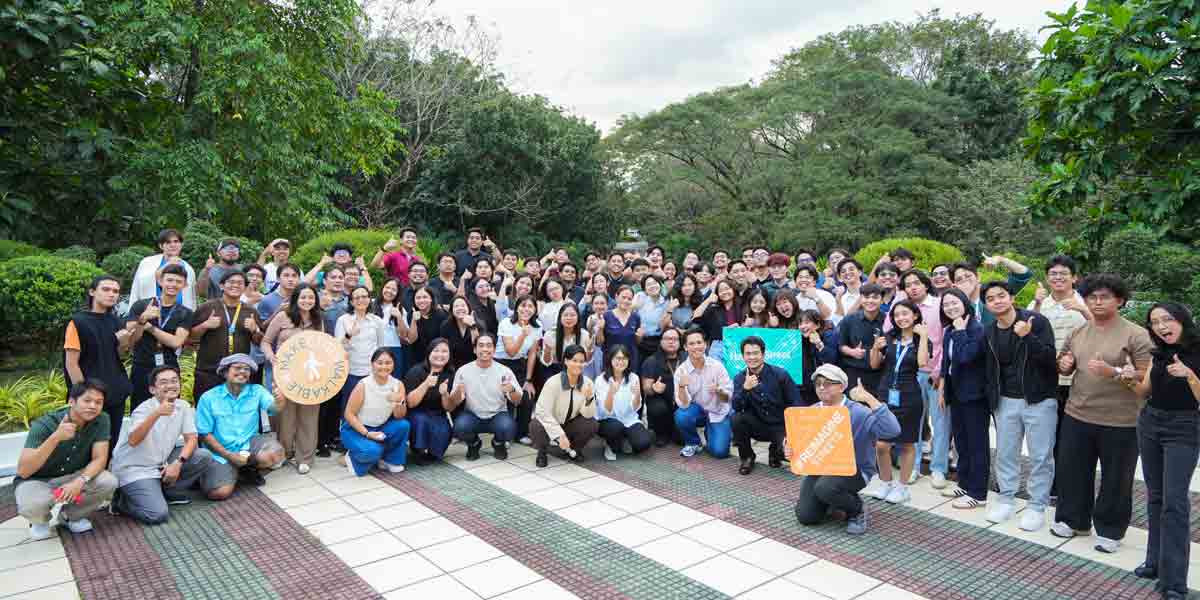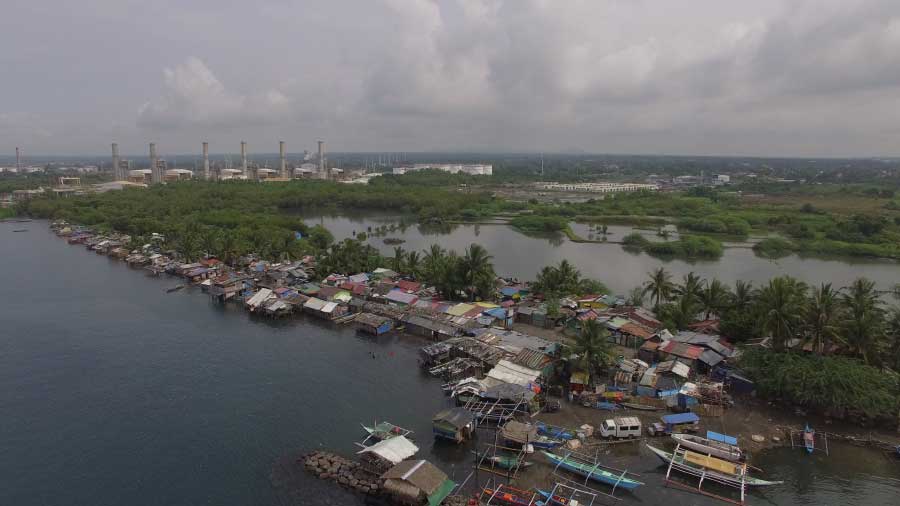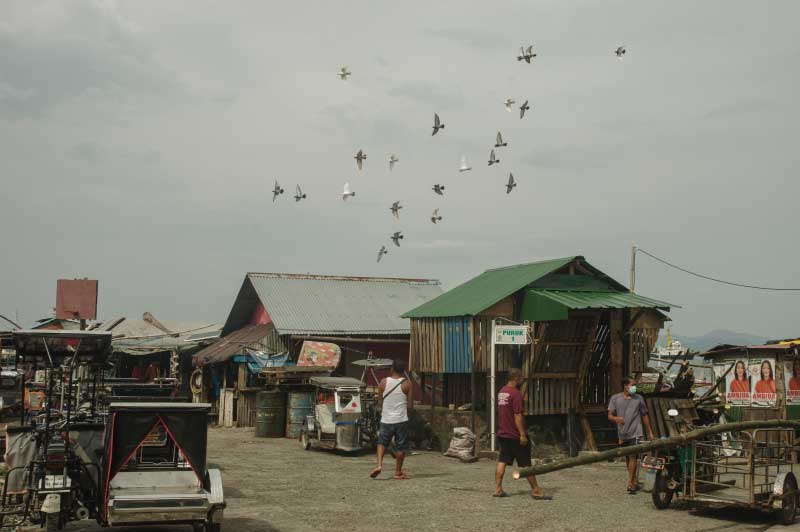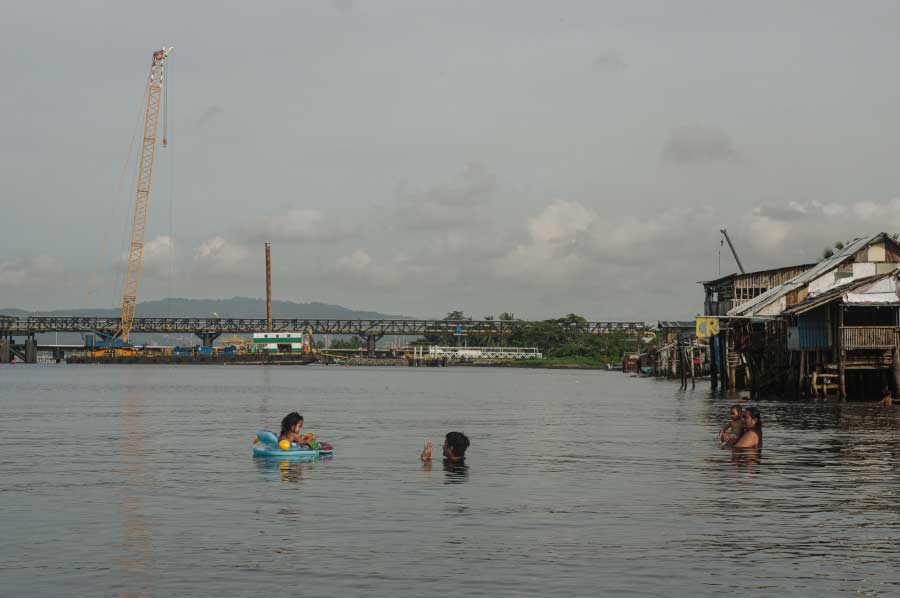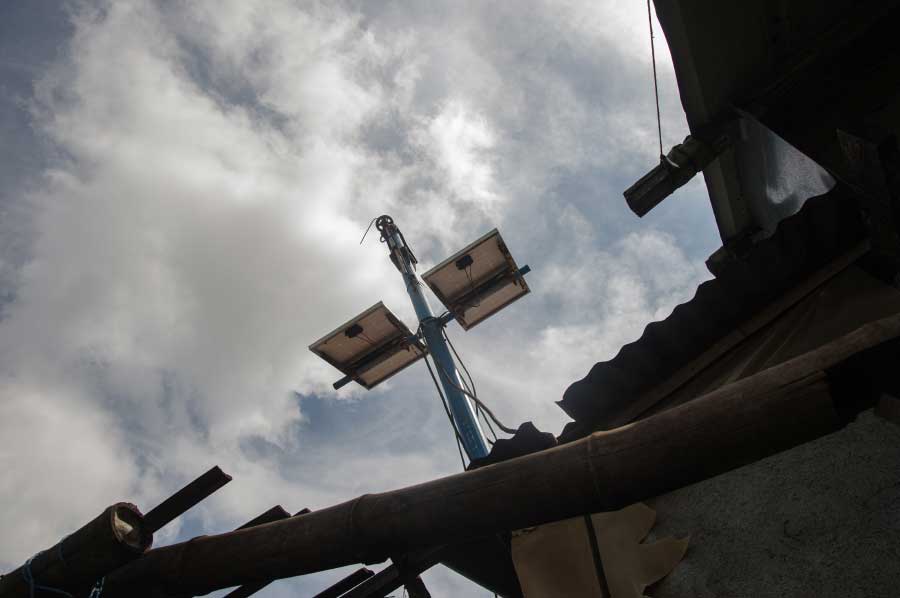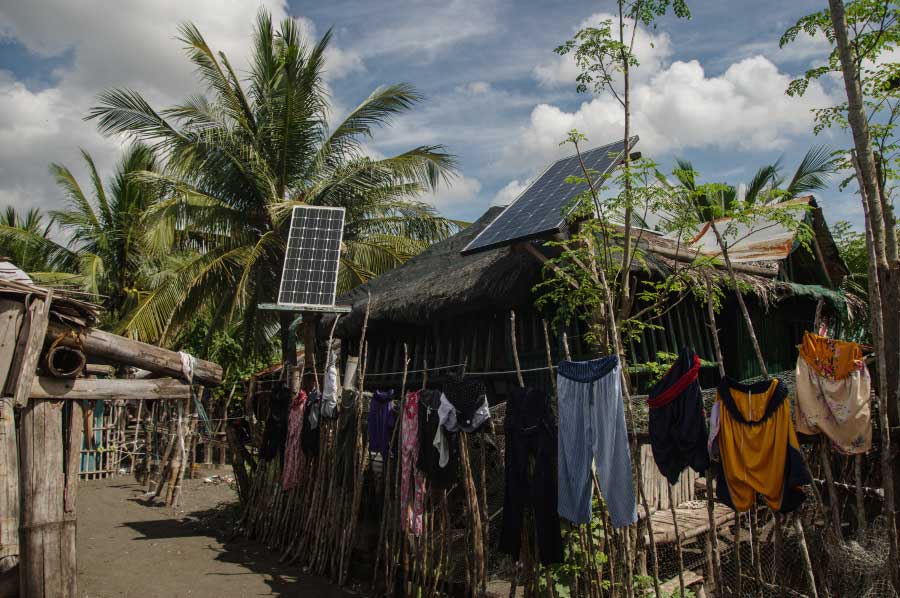
By Cherry Salazar
Philippine Center for Investigative Journalism
Last of three parts
The Philippines detours from the renewable energy path to dirty, expensive and imported fossil gas.
STA. CLARA, BATANGAS – Residing in the coastal village of Sta. Clara in Batangas City for three generations, the Mendozas witnessed how a community once lined with aroma and talisay trees had turned into a marshy area now cornered by gas facilities.
Located only a few hundred meters away from their home are the Avion, Sta. Rita, San Lorenzo, and San Gabriel natural gas-fired power plants.
These power plants, along with the Ilijan Power Plant also in Batangas City, source their gas supply from the Malampaya offshore field. Altogether, the five power plants provide 19% of the country’s total power requirement and 27% of the Luzon grid’s, according to data from the Department of Energy (DOE).
Even if gas facilities could be seen from within their community, Sta. Clara residents have yet to be connected to power lines due to a land dispute. They are among the remaining 1.58% or 210,538 unenergized households in Luzon, according to government data.
“Walang kuryente dito… Hindi kami binibigyan ng kuryente kaya asa lang kami nung una sa gas (lamps) (There is no power here… They don’t provide access to electricity here so we only initially rely on gas [lamps]),” said Bibiano Mendoza, a second-generation fisherman in Sta. Clara.
Photo 2: Sta. Clara community
Grappling in the dark could well be a familiar situation for the rest of Luzon in the coming years. Malampaya’s service contract expires in 2024, and its remaining reserves are expected to be depleted by 2027.
The National Grid Corp. of the Philippines (NGCP) has warned of yellow alerts, or thin power reserves, for the majority of 2023. A yellow alert is issued when contingency reserves fall below the ideal level of 647 megawatts (MW).
Since 2001, the country’s primary source of natural gas has been the Malampaya gas field. At its peak, DOE said Malampaya was able to supply around 40% of the country’s energy needs.
In 2020, the share of natural gas in the country’s power generation was at 19%, DOE data showed. Renewable energy (RE) contributed more, albeit less than a quarter, while coal generated more than half of the country’s power. (See Chart 1)

With a looming energy crisis, the government is turning to imported liquefied natural gas (LNG) to cover Malampaya’s supply shortfall. LNG is also seen as a transition fuel to help the country meet its climate promise of a 75%-reduction in greenhouse gas emissions by 2030 while RE facilities and mechanisms are being built.
Given the complementary nature of RE and LNG, DOE officials told the Philippine Center for Investigative Journalism (PCIJ) that the two energy sources should be seen as partners, not competitors.
But the think tank Center for Energy, Ecology, and Development (CEED) said the government’s pivot to LNG was yet another “detour” in energy transition when a direct path to RE was possible.
A new detour
In 2008, the Philippines passed Republic Act No. 9513, or the Renewable Energy Act. It was the first and most comprehensive RE law in Southeast Asia and was expected to push for energy self-sufficiency in the country.
“We’ve been detoured from tapping a 100-percent renewable energy system… That’s a decade lost. We’re confronting a new detour now,” said CEED executive director Gerry Arances.
Contrary to popular claims, experts pointed out that LNG is neither cheap, as it is subject to a highly volatile market, nor clean, as it is a fossil fuel.
“The idea that LNG is a transition fuel is… fundamentally flawed,” said Sam Reynolds, energy finance analyst for Ohio-headquartered Institute for Energy Economics and Financial Analysis (IEEFA).
The Philippine Energy Plan wants RE to contribute between 35% to 50% of the country’s power generation by 2040, with LNG filling the gaps in the transition.
Assuming a continuation of present trends, or what is also called a “reference scenario,” natural gas is seen to take over coal as the major fuel source for power generation in 2040, with its share increasing to 40.3% from 19.2% in 2020.
In a “clean energy scenario,” which requires greater decarbonization efforts, natural gas would take 26.6% of power generation, with RE generating half of the country’s power.

DOE projected that the country’s peak demand would increase “almost four-fold, growing 6.6% annually over a 20-year period,” growing from 15,282 megawatts (MW) in 2020 to 54,655 MW in 2040.
(Watt-hours are a measurement of the total amount of electricity used during a certain period. One kilowatt (kW) is equivalent to 1,000 watts. One kilowatt-hour is one-hour of use of electricity at 1,000 watts. In the Philippines, the average monthly electricity consumption of one household is 200 kwH, according to Meralco estimates. Megawatt (MW) is typically used to measure the consumption of a certain area or the output of a power plant. One MW is equivalent to one million watts. A coal plant, for example, usually has an output of 600 MW. The Luzon Grid has a system peak demand of 13,125 MW.) (See sidebar: Green glossary: breaking down the carbon jargon.)
To reach the country’s energy targets by 2040, power generation facilities generating 20,810 MW under the reference scenario and 15,430 MW under the clean energy scenario would be necessary, Oil Industry Management Bureau (OIMB) director Rino Abad told PCIJ in an interview.
This would translate to about 25 metric tons per annum (MTPA) under the reference scenario and 19 MTPA under the clean energy scenario, said Abad.
Bridge fuel?
At present, there are seven ongoing government-approved LNG terminal projects, five of which are in Batangas City. The other two are in Pagbilao, Quezon, and Mariveles, Bataan. Two of the three committed gas-fired power plants are also located in Batangas City. This does not include other LNG projects in the pipeline. (Committed projects are those that have secured funding and other necessary permits.)

Of the ongoing terminal projects, two are expected to be operational by 2023: FGEN LNG Corp.’s floating storage and regasification unit (FSRU) and Linseed Field Corp.’s floating storage and inland regasification units, with a combined total capacity of 8.26 MTPA.
This will not be enough to meet the government’s targets. That’s why, Abad said, other LNG projects should continue despite criticisms and contentions from environmental groups.
All seven approved LNG terminals could yield up to 21.98 MTPA when operational, well within the government’s clean energy scenario target and a little short of the reference scenario target.
But CEED executive director Gerry Arances said that over 20 other LNG projects in the pipeline, including nine LNG terminals, were projected to generate up to 29.9 gigawatts, or at least nearly half more than the government’s targets for 2040.
“That is a lot! ‘Yun pa lang, doon sa numero na ‘yun, magtatanong ka na kung bridge fuel ba ‘to (With that number, you already wonder if it’s really bridge fuel),” Arances said.
Photo 3: Gerry Arances profile

Imported LNG goes through an elaborate process: First, natural gas must be cooled down until it liquefies, so it becomes easier to transport. Then, the liquefied gas will be shipped to receiving terminals around the world where it will be stored and regasified.
This “more complicated supply chain” by itself merits additional costs, said IEEFA’s Reynolds. The natural gas industry is characterized by very small returns accrued over a long time, which means investors can be expected to operate for a long term to recoup their intensive capital and earn profits.
Reynolds called the influx of proposed LNG projects in the Philippines an “investor frenzy.”
“We’re not seeing a pipeline of projects that is tailored to what the Philippines needs. We’re seeing an investor frenzy where they’re trying to rush in, sign long-term contracts, and guarantee themselves a profit,” Reynolds told PCIJ in September 2022.
“And it will come at the expense of the entire Philippines’ economy,” he said, warning of rate hikes in the country. The Philippines is among Asian nations paying the highest power prices, next only to Japan and Singapore.
LNG prices had been volatile over the past years. When power demand was low at the height of the pandemic, prices fell to their lowest point.
Geopolitical complications also exacerbated this volatility. As the Russian invasion of Ukraine persists, Europe is forced to purchase and import fuel elsewhere. Damages to Nord Stream, an underwater pipeline bringing Russian gas to Europe, also caused LNG demand and prices to surge in late 2022.
This makes the global market for a finite resource more competitive where poorer countries, such as the Philippines, have to compete against richer countries for supply.
In an email to PCIJ, First Gen Corp. corporate communications head Ricky Carandang acknowledged the volatility of the LNG market. But while “tightness in supply is expected to persist until around 2026,” Carandang said that by then, large and new supply from ongoing projects in other countries would have come online.
Carandang said a way to avoid exposure to price spikes “is through longer-term contracts where the price formula is linked to a widely traded benchmark… (and) the buyer commits to buy significant volumes of LNG annually for several years.”
Atlantic, Gulf & Pacific Co. (AG&P) Chairman and Chief Executive Officer Joseph Sigelman also dismissed LNG’s market volatility as temporary and expected.
“What causes the prices (to increase) is a temporary dislocation with respect to infrastructure and supply, but the actual supply in the world is sufficient,” Sigelman said in a June 2022 interview with the ABS-CBN News Channel.
“If you are to buy LNG in a long-term contract, you will find the pricing is quite benign even despite short-term volatility,” he added. “This volatility is there with every fuel and commodity in the very short term, but right across the board, there is no question that clean natural gas is available in abundance and with a favorable pricing for years to come.”
While investors said they expected prices to stabilize by the time LNG projects in the country went online, experts said prices were unlikely to wane.
Alberto Dalusung III, energy transition adviser for the Quezon City-based Institute for Climate and Sustainable Cities (ICSC), projected that LNG prices “will stabilize but not at the previous levels.”
“Even if it levels off at $15 (P827), it’s still at least double what it was before,” said Dalusung. “The way I see it, renewables will obviously be cheaper than fossil fuels now.”
The International Group of Liquefied Natural Gas Importers (GIIGNL) also stated in its 2022 annual report that LNG demand in Asia outpaces supply growth.
“LNG production has been struggling to keep pace with demand, which sent spot LNG prices upwards. While 7.4 MTPA of new capacity came onstream, 5 MTPA of which in the United States, global LNG exports were affected by unscheduled maintenance and shortfalls in feed gas,” it read.
LNG terminals of AG&P subsidiary Linseed and First Gen subsidiary FGEN LNG have repeatedly pushed back their commercial operations. Dalusung attributed the delays to soaring LNG prices.
“We can only imagine how much more expensive it would be for both investors and consumers to use LNG,” he told PCIJ in October 2022. “Let’s say they finish, how much do you think they will pay for LNG? That’ll be like three times more expensive than what we originally thought.”
Long-term supply contracts with shipments before 2026 are already sold out globally, according to a survey by Japan’s trade ministry. Japan is a leading importer of LNG.
“Currently, all long-term contracts that can start supplying by 2026 can be said to be sold out. The LNG procurement environment has changed completely. Procurement can also be said to be in a state of war,” they said.
This may force LNG players in the Philippines to “rely solely on the volatile spot market for several years,” IEEFA said in its Global LNG Outlook 2023-27 report released in February 2023.
Proponents of LNG terminals in the country have yet to secure long-term supply contracts.
The Philippines needed only to look at its Asian neighbors to realize the challenges in procuring LNG, said Reynolds.
Bangladesh decided to buy from the international spot market in 2020 due to low prices. However, prices have skyrocketed since then, leading to daily “load-shedding” or scheduled power outages in the country.
Since October 2021, a single LNG shipment to Bangladesh could cost up to $135 million (P7.34 billion), or “five times the cost in May 2021 and 10 times the cost in May 2020,” according to an IEEFA report.
“Of the spot market tenders issued (in 2022), 40% went unawarded because of unaffordable bid results. So, you get situations in which countries are not able to afford LNG,” said Reynolds.
Pakistan, meanwhile, signed long-term contracts with LNG suppliers in 2015. These power supply contracts often stand for up to 20 years and are seen as a way of mitigating exposure to market volatility. But two of Pakistan’s contractors defaulted and missed their deliveries of LNG cargos in 2021.
“When spot market prices are high, suppliers see an incentive to default on their long-term commitments to deliver LNG and sell LNG into more expensive markets elsewhere,” said Reynolds.
He added that while contractors were obligated to pay penalties for any defaulted cargo, they were “willing to eat the penalty (because) the profit would justify sending the cargos elsewhere.”
Bloomberg reported that LNG suppliers were also hesitant to sell fuel to Pakistan for fear that it might not be able to meet future payments, as the country continues to struggle with high inflation and falling currency reserves. In January 2023, nearly the entire country was without energy for a day.
Sri Lanka has also been suffering from severe fuel shortages, prompting inflation surges and widespread protests.
“As an LNG buyer, like the Philippines, you want to have a balanced portfolio of both spot market purchases, which you can use to buy LNG when you need it, and long-term contracts, which ensure stability,” said Reynolds.
The energy supply crisis was the most severe risk with an impact on a global level, according to the Global Risks Perception Survey of the World Economic Forum released in January 2023. This energy crunch, among others, is expected to increase the cost-of-living crisis, which is seen as a bigger global risk in the next two years than the climate crisis.
More potent emission
Natural gas is also often labeled the “cleanest fossil fuel” with significantly less carbon emission than coal and oil, supposedly making it an ideal alternative in the transition to renewables.
A study conducted by Washington-based Center for Liquefied Natural Gas – which measured emissions from every part of the LNG process and the coal life-cycle in five international markets – showed that existing and “efficient” coal-fired power plants would “still emit more greenhouse gas than the high case for LNG.”
However, CEED’s Arances pointed out that most research do not account for methane emission and leakages throughout the LNG value chain process.
A main component of natural gas is methane, which has up to 80 times more heat-trapping potential than carbon dioxide over a 20-year period, according to New York-headquartered Environmental Defense Fund.
The energy sector is estimated to have accounted for 37% of methane emissions globally, according to the latest Methane Tracker Data of Paris-based International Energy Agency (IEA) released in February 2023. Of 133.3 million tons (Mt) in methane emissions from the energy sector in 2022, 27.5% or 36.7 Mt were due to natural gas.
IEA data also showed that gas pipelines and LNG facilities around the world emitted methane amounting to 11,962 kilotons (kt): 65% or 7,802 kt of which were fugitive emissions, or those that occurred from unintended leakages.

In 2021, the “biggest year-on-year jump in methane concentrations” in 40 years was recorded by the Geneva-headquartered World Meteorological Organization (WMO). Methane, the WMO said, is the second largest contributor to climate change.
“There are cost-effective strategies available to tackle methane emissions, especially from the fossil fuel sector, and we should implement these without delay,” read the WMO report released in 2022 ahead of the United Nations climate change conference, COP27. “However, methane has a relatively short lifetime of less than 10 years and so its impact on climate is reversible.”
But coal is perceived to be more of a pollutant, Arances said, because pollution brought by coal is very visible compared to that of gas. “Ganun ang nature ng tao e. Kapag hindi mo nakikita at very cerebral ay hindi mo naiintindihan (That’s human nature. If you don’t see it and it’s very cerebral, you don’t understand it).”
AG&P’s Assistant Vice President for Business Development Levi Alan Vitug assured residents during the public scoping in September 2020 that “there should be no leak.”
“From a commercial perspective, a leak is a loss in profit,” Vitug was quoted as saying in the EIS. Linseed’s terminal will be designed to be able to “recondense” a “boil-off gas” that will then be brought back into the tank, he said.
“When there’s still boil-off gas that is not collected, in an emergency situation, there is a flare tower that will burn that remaining gas because it will be better to be produced as a small amount of carbon dioxide than to leak as methane,” Vitug was quoted as saying during a February 2021 public hearing.
‘Not RE’s competitor, but partner’
Arguments against LNG are taking off from the idea that 100-percent RE is possible, energy undersecretary Alessandro Sales told PCIJ in October 2022. “But we cannot, given the present technology and situation, enjoy 24/7 power supply. That’s reality,” Sales said.
Energy officials pointed to the need to develop the ancillary market to secure power supply. A gas-fired power plant could be designed to meet baseload and peaking requirements, which would help avert outages, they said.
LNG is also known for its flexibility and quick start, ramp-up, and cool-down times, which could complement the intermittency and accommodate the fluctuations of RE.
Sales stressed that there is “no conflict” between the two technologies, so natural gas and RE should not be seen as competitors but as partners.
Photo 4: DOE officials

Carandang noted that as an archipelago, the Philippines is also “vulnerable to supply
disruptions and hazards such as typhoons,” and has “limited internal interconnections
through costly underwater transmission lines.”
However, studies have shown that a transition toward 100% RE will not only be technically feasible and cost-effective but also provide socioeconomic benefits. According to think tank Climate Tracker, renewables can be scaled up to 81% of the Philippines’ energy generation capacity by 2030 and 100% by 2050.
Distributed RE (DRE) systems, which allow for the generation of energy near the point of use instead of centralized mechanisms, such as power plants, can also reduce the need for long transmission lines that may be exposed to natural hazards.
Research published in the scientific journal Renewable and Sustainable Energy Reviews found that a 100% renewable transition in the Philippines “will not only ensure low vulnerability towards climate change events but also external threats such as market speculations, stranded assets and the geopolitics involving imported fossil and nuclear fuels, and at the same time, reducing GHG emissions and air pollution.”
Energy officials admitted that the “ultimate target to go green is on the horizon” but “in terms of practical application, there are certain things that have to be done.”
In October 2022, DOE issued a circular making RE a priority and must-dispatch in the grid, which Sales explained would be a risk for LNG businesses. This, as well as international climate agreements, show the government’s commitment to prioritize renewables, he said.
Carandang agreed that there was “more than sufficient room for the growth of renewables.”
“Power supply contracts expire every few years, and with growing public and market demand for RE, contracts will increasingly be fulfilled with renewable energy,” he said.
No definite timeline, exit policies
While experts agreed that some LNG would be necessary in the mix as the country moves toward renewables, the lack of clear policies could mean the Philippines would be “locked in” to fossil fuel.
IEEFA’s Reynolds said it was “concerning” for the Philippines to have “no coherent plan” regarding LNG imports and operations despite the approval of several gas projects.
“How long are contracts lasting? Where is the supply coming from? What are the pricing terms? The list goes on and on. And I’d have yet to see any answers to these kinds of key questions,” said Reynolds.
“You have all kinds of questions that need to be answered in order to ensure that supply is going to be there when you need it and that supply is going to be affordable,” he said.
There is also no legislation on LNG, although several bills are going through the Senate and the House of Representatives.
Reynolds also cautioned that instability and uncertainty in the market could lead to stranded assets — capacity and capex (capital expenditure) costs of which could be passed on to consumers.
First Gen’s Carandang said this was why the firm was building an interim offshore, instead of a traditional onshore, LNG terminal utilizing an FSRU.
The FSRU “reduces the impact of potential stranding by reducing the capital cost associated with fixed immovable assets, as [its use] could be discontinued and relocated,” he said.
PCIJ has reached out to AG&P and Linseed — which has an ongoing LNG terminal project that is expected to go online in 2023 — but has yet to receive any response as of this writing.
Energy officials said the possibility of LNG facilities being stranded or unused was far-fetched. Sales, a former executive in a private oil exploration firm, said investors were expected to be “astute” in their business prospects, for instance, by monitoring the growth rate of RE and its impact on gas.
OIMB’s Abad pointed out that investors were also expected to have separate contracts with suppliers and distributors before developing a project.
Power supply agreements are auctioned six years in advance, as gas projects take at least four years to build, Abad said. An investor will also negotiate with LNG suppliers in anticipation of future operations, he said.
So far, only Excellent Energy Resources, Inc. (EERI)’s proposed 1,700-MW regasified LNG-fired power plant has a power supply agreement. EERI is a subsidiary of SMC Global Power Holdings Corp.
The target for LNG terminals to go online by the first quarter of 2023 was also planned, taking into account Malampaya’s depletion in 2024, said Abad. “It’s not an accidental timeline,” he said.
However, energy officials could not commit to a particular timeline on how long LNG would be utilized as bridge fuel.
“The plan exists as targets but in terms of timeline, as you move along, it adjusts depending on which technology picks up, gets cheaper, so there’s flexibility,” said Sales.
The energy undersecretary explained that some variables could be controlled, such as the number of RE projects, but there were others, like the discovery and production of indigenous gas supply, that were outside their control and were limiting factors in setting schedules.
There could also be breakthrough technologies that would render natural gas moot, Sales said. “You try to keep all your options open.”
‘More indigenous, more renewables’
ICSC’s Dalusung said that while the country’s power system is dependent on investments from the private sector, the private sector also relies on policy cues from the government.
“The reason for our current situation is because of certain policy cues from the government,” he said. “[The previous administration] started off technology-neutral even if our laws are clearly not technology-neutral… We should have done more indigenous, more clean, more renewable [power projects].”
While RE continues to be developed, DOE is set to continue exploration for indigenous supply. More domestic sources will make prices cheaper, supply more secure, and the energy mix more self-sufficient.
“To achieve the targets, we would require so much more capacity in LNG, but this could actually be displaced by new discoveries of natural gas in the Philippines,” said Sales.
For many years, domestic resource exploration was sidetracked by a territorial dispute in the West Philippine Sea. With the moratorium on exploration now lifted, the DOE expects drilling operations in six oil prospects and five gas prospects. The energy department has so far approved drilling in an offshore oil field in northwest Palawan in the first half of 2023.
The energy dichotomy should be between imported and domestic sources, not LNG and RE, said IEEFA’s Reynolds. This was an important distinction, he said, because fuel importation was one of the main factors behind high power prices.
Until the Philippines finds its new Malampaya, Sales said DOE would have to balance climate and energy security commitments. This means LNG will still have to fill gaps until a more viable option is available.
But for Sta. Clara residents, neighbors of natural gas-fired power plants, energy self-sufficiency has become a way of life. As their connection to the grid remains in limbo, they are taking it upon themselves to energize their homes by installing solar panels.
Photo 5: Solar panels
If anything, this shows the strength of renewable energy, said CEED’s Arances. “It’s a matter of when. It’s not a matter of how.” –PCIJ, March 2023


